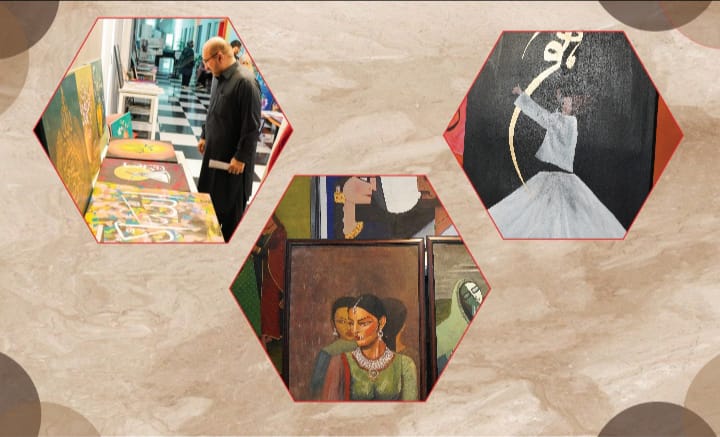
On September 30th, 2023, an Art and Books Exhibition was organized by The Order of Pen at NIC Peshawar. The event turned out to be a great success in connecting the audience and artists through majestic artworks. Additionally, the artist participants were overwhelmed by the audience response at the exhibition. Grateful for the opportunity given, many expressed their desire to conduct more such events. From nascent to expert, all the artists displaying their artworks were interviewed about their inspirations and aspirations. As diverse as it could be, everyone shared their own unique view of the world.
Predominantly, among the participating artists, the majority were self-taught. Only a scant number of artists were pursuing art as a full-time vocation regardless of their impeccable ability to capture the essence of existence and the associated agonies in their work. For many, art was a side hustle or a hobby, a means by which they sought to satisfy their inner creative urges. Some among them were lawyers, medical students, or professionals in technical fields. Though there’s no shame in pursuing these noble professions, there’s equally no shame in becoming a full-time artist. However, when asked about art pursuits, many draw upon core social issues.
Based on Artists’ shared experience and usual observation, the rationale of choosing not to become an artist in our society varies from socio-cultural to socio-economic and political factors. Let’s explore how different dynamics compel a middle class passionate artist to become a bureaucrat.
Beginning with choosing a career, unfortunately in Pakistan, choosing a career in art is often perceived as synonymous with being unworthy. It’s a society where skills and interests typically don’t carry much weight in the process of career selection. This may be primarily because of the notion that one’s sense of worthiness is closely tied to capital generation. Besides, the viability of a profession is often judged by the amount of revenue it can generate. Since there is higher level of uncertainty and risk in an artist’s life compared to other professions, a middle class person would never dare to become an artist. As one artist shared regarding pursuing art as a career, “My parents advise me not to go for it (art). Besides, they often tell me not to waste my time on such things as it is not going to be beneficial in long run.”
Similarly, those who are courageous enough to risk their careers, face utter disappointment and dire regrets. There is no infrastructure or art schools available country wide. Majority are in big cities, which again is unaffordable for a child of a common man. Having said that, those who can manage are unable to continue it. Firstly, due to the elite discrimination and adjustment issue, and secondly, the continuous turmoil of increasing financial burden such as buying art essentials, participating in events, etc hinder them from pursuing art as a career. Likewise, people in rural areas have no access at all.
Financial issues are indeed genuine concerns that cannot be overlooked. Producing artwork requires not only the necessary painting supplies but also a significant amount of dedication and time. Subsequently, the artwork produced will be unaffordable. For the fact that the substantial portion of the population neither has the means to purchase art nor know how to appreciate its value. It’s a luxury a common man can’t afford to even appreciate. Tuned in a survival-focused mode, an artist can neither manage to reach an audience nor audience can manage to support them.
Moreover, speaking of support dynamics, there is often a clash of sentiments between the audience and artists. The religious, cultural, and sociopolitical beliefs of the audience can act as a form of censorship on the creativity of artists. People tend to evaluate artwork based on the religious rules, determining what is permissible and what is not. For instance, a fine art student at the exhibition shared his experience, stating, “I paint Mughal Art, particularly women of that era. However, I often hear that it’s not allowed in Islam. Some people even completely disregard my paintings. Unfortunately, people often fail to connect with and appreciate my art, which has taken me years to create.”
Thus, it could be said that artists are born in Pakistan but they die before blossoming. Financial, religious, and social issues curb the growth of an artist’s mind. Struggling to manage between passion and responsibilities, responsibilities often win. Country’s stakeholders need to immediately address the issue. Building infrastructure across the country for art education and propagation with ‘no to minimum’ fee amounts will sort the issue to a larger extent. Public exhibitions open to all viewers and artists will further promote art and art value among the masses. Above all, awareness and state funding of artists could really assist in increasing the ratio.
The Order of Pen has taken the initial step. It’s high time that all of us both as an artist and audience come forward and put our contribution. If you are an artist and have suffered, let us know in the comment section what is the biggest hurdle you have ever faced or what do you think is the major reason for the gap between audience and artists.






Leave a Reply